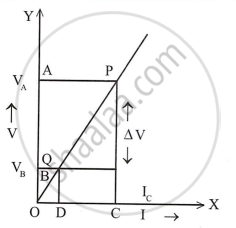Advertisements
Advertisements
प्रश्न
Draw a I–V graph for a linear resistor. What does its slope represent?
उत्तर

One draws an I-V graph of a linear resistor. The slope represents the conductor's resistance, R.
Slope `("V"_"A" - "V"_"B")/("I"_"C" -"I"_"D")`
`(Δ "V")/(Δ "I") = "R"`
Graph for V vs I or slope
`(Δ "I")/(Δ "V") = 1/("Resistance of the conductor")`
APPEARS IN
संबंधित प्रश्न
Two copper wires are of the same length, but one is thicker than the other. Which wire will have more resistance?
How does the resistance of a wire depend on its length? Give a reason for your answer.
Assertion (A): Copper is used to make electric wires.
Reason (R): Copper has very low electrical resistance.
If the area of cross-section of the conductor is doubled its resistance gets ______.
Three resistors are connected in series with a cell. If the current in each resistor is 1.5A, then the current through the cell will be ______.
A rheostat is also known as fixed resistance.
Match the following:
| Column I | Column II | ||
| 1. | Resistor | a. | Galvanometer |
| 2. | Connecting wire | b. | Voltmeter |
| 3. | Current in an electric circuit | c. | Copper |
| 4. | Potential difference | d. | Constantan |
Define the following:
Fixed resistor
Define the following:
Variable resistor
Two copper wires are of the same length, but one is thicker than the other. Which wire will have more specific resistance?
